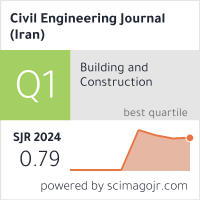Effect of Non-Class Fly Ash on Strength Properties of Concrete
Downloads
Doi:10.28991/CEJ-2024-010-03-02
Full Text:PDF
Downloads
[2] Attarde, S., Marathe, S., & Sil, A. (2014). Utilization of fly ash in construction industries for environment management. International Journal of Environmental, 3(2), 117-121.
[3] Lee, S. H., Sakai, E., Daimon, M., & Bang, W. K. (1999). Characterization of fly ash directly collected from electrostatic precipitator. Cement and Concrete Research, 29(11), 1791–1797. doi:10.1016/S0008-8846(99)00169-6.
[4] Das, B. B., & Pandey, S. P. (2011). Influence of Fineness of Fly Ash on the Carbonation and Electrical Conductivity of Concrete. Journal of Materials in Civil Engineering, 23(9), 1365–1368. doi:10.1061/(asce)mt.1943-5533.0000298.
[5] Sun, Y., & Lee, H. (2020). Research on properties evolution of ultrafine fly ash and cement composite. Construction and Building Materials, 261. doi:10.1016/j.conbuildmat.2020.119935.
[6] Amran, M., Debbarma, S., & Ozbakkaloglu, T. (2021). Fly ash-based eco-friendly geopolymer concrete: A critical review of the long-term durability properties. Construction and Building Materials, 270, 121857. doi:10.1016/j.conbuildmat.2020.121857.
[7] Herath, C., Gunasekara, C., Law, D. W., & Setunge, S. (2020). Performance of high volume fly ash concrete incorporating additives: A systematic literature review. Construction and Building Materials, 258, 120606. doi:10.1016/j.conbuildmat.2020.120606.
[8] Hino Junior, J. R., Balestra, C. E. T., & Medeiros-Junior, R. A. (2021). Comparison of test methods to determine resistance to chloride penetration in concrete: Sensitivity to the effect of fly ash. Construction and Building Materials, 277, 122265. doi:10.1016/j.conbuildmat.2021.122265.
[9] Singh, N. B., & Middendorf, B. (2020). Geopolymers as an alternative to Portland cement: An overview. Construction and Building Materials, 237, 117455. doi:10.1016/j.conbuildmat.2019.117455.
[10] da Silva Magalhí£es, M., Cezar, B. F., & Lustosa, P. R. (2023). Influence of Brazilian fly ash fineness on the cementing efficiency factor, compressive strength and Young's modulus of concrete. Developments in the Built Environment, 14, 100147. doi:10.1016/j.dibe.2023.100147.
[11] Felix, E. F., Carrazedo, R., & Possan, E. (2021). Carbonation model for fly ash concrete based on artificial neural network: Development and parametric analysis. Construction and Building Materials, 266, 121050. doi:10.1016/j.conbuildmat.2020.121050.
[12] Zhang, C., Fu, J., & Song, W. (2023). Mechanical model and strength development evolution of high content fly ash–cement grouting material. Construction and Building Materials, 398. doi:10.1016/j.conbuildmat.2023.132492.
[13] Nguyen, T. B. T., Saengsoy, W., & Tangtermsirikul, S. (2018). Effect of initial moisture of wet fly ash on the workability and compressive strength of mortar and concrete. Construction and Building Materials, 183, 408–416. doi:10.1016/j.conbuildmat.2018.06.192.
[14] Fernando, S., Gunasekara, C., Law, D. W., Nasvi, M. C. M., Setunge, S., & Dissanayake, R. (2023). Assessment of long term durability properties of blended fly ash-Rice husk ash alkali activated concrete. Construction and Building Materials, 369, 130449. doi:10.1016/j.conbuildmat.2023.130449.
[15] Kasaniya, M., Thomas, M. D. A., & Moffatt, E. G. (2021). Efficiency of natural pozzolans, ground glasses and coal bottom ashes in mitigating sulfate attack and alkali-silica reaction. Cement and Concrete Research, 149. doi:10.1016/j.cemconres.2021.106551.
[16] Andrew, R. M. (2018). Global CO2 emissions from cement production. Earth System Science Data, 10(1), 195–217. doi:10.5194/essd-10-195-2018.
[17] Hossain, M. M., Karim, M. R., Hasan, M., Hossain, M. K., & Zain, M. F. M. (2016). Durability of mortar and concrete made up of pozzolans as a partial replacement of cement: A review. Construction and Building Materials, 116, 128–140. doi:10.1016/j.conbuildmat.2016.04.147.
[18] ASTM C595/C595M-21. (2023). Standard Specification for Blended Hydraulic Cements. ASTM International, Pennsylvania, United States. doi:10.1520/C0595_C0595M-21.
[19] Alaj, A., Krelani, V., & Numao, T. (2023). Effect of Class F Fly Ash on Strength Properties of Concrete. Civil Engineering Journal (Iran), 9(9), 2249–2258. doi:10.28991/CEJ-2023-09-09-011.
[20] Wang, Z. (2011). Influence of fly ash on the mechanical properties of frame concrete. Sustainable Cities and Society, 1(3), 164–169. doi:10.1016/j.scs.2011.06.001.
[21] Aslani, A., Hachem-Vermette, C., & Zahedi, R. (2023). Environmental impact assessment and potentials of material efficiency using by-products and waste materials. Construction and Building Materials, 378. doi:10.1016/j.conbuildmat.2023.131197.
- Authors retain all copyrights. It is noticeable that authors will not be forced to sign any copyright transfer agreements.
- This work (including HTML and PDF Files) is licensed under a Creative Commons Attribution 4.0 International License.![]()















